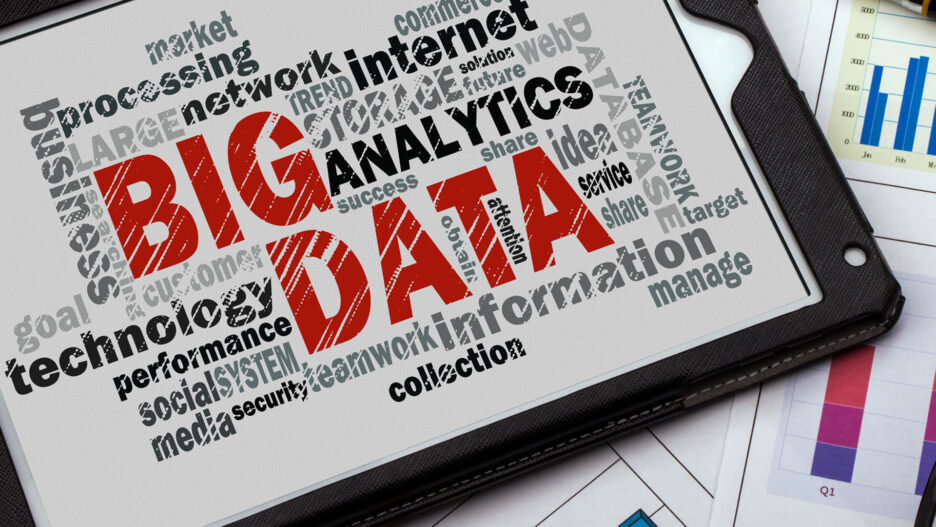What is big data analytics?
SAS defines Big Data Analytics as the complex practice of examining “large amounts of data to uncover hidden patterns, correlations, and other insights” such as market trends, customer preferences, online behavior, and more, to help organizations make data-driven, informed, and intelligent business decisions.
Typically, Big Data is associated with data sets that due to their colossal size cannot be processed via traditional processing methods and are beyond the capabilities of traditional relational databases. Big Data Analytics makes use of powerful and advanced analytic techniques and tools to process very large and diverse data sets that include structured, semi-structured, and unstructured data from different sources and in different sizes. We’re talking terabytes to zettabytes.
Nowadays, Big Data is not sourced from the typical origin points. Instead, Artificial Intelligence, Machine Learning, and the Internet of Things are among the key players who are driving new data complexity from sensors, devices, video/audio, networks, log files, transactional applications, social media, and much more. An added layer of complexity exists as the data is being generated in real-time and at a very large scale.
Big Data Analytics is of great importance in a world that is entirely data-driven. Data analysts, researchers, and business users have the compelling need to make better and faster decisions from the available data. To get there, users leverage text analytics, machine learning, predictive analytics, data mining, statistics, natural language processing, and much more, to gain insights and intelligence from data.
With so much potential left to be discovered in data and with more businesses than ever before which rely heavily on data, Data Analysts play a fundamental role in extracting insights and valuable intelligence that drives businesses forward. Let’s examine this role further.
How does the big data analyst work?
First of all, who exactly is a Data Analyst? A Big Data Analyst is a professional who collects, processes, and performs statistical analysis of data. Data analyst skills differ significantly from data scientists as the latter typically have more expertise in advanced mathematical and statistical skills. But these two roles do share the common goal of discovering value in data that can be used to answer questions or solve business problems.
Rooted in the statistics field, the role of the big data analyst makes use of programming languages and analytical techniques to pull, sort, and interpret data to benefit an individual or organization.
Depending on the level of seniority, some of the main responsibilities of big data analysts include:
- Coordinate with IT teams, management, and data scientists to define the organizational goals of an analytical project.
- Mine data from primary and secondary sources.
- Clean and filter data to eliminate irrelevant sets.
- Analyze and interpret data results through the use of standard statistical tools, methods, and techniques.
- Identify trends, correlations, and patterns in data.
- Pinpoint areas of opportunity for process improvement.
- Create reports and data visualizations to help upper management understand the discoveries made on data sets.
- Design, create and maintain relational databases, NoSQL databases and data systems.
- Analyze problems and issues with data to channel them through the right elements.
How to become a data analyst
Oftentimes, the data analyst role is considered an umbrella term for other roles such as market analysts, quantitative analysts, business intelligence analysts, data warehouse analysts, business systems analysts, operations analysts, and other field-specific positions that are closely related.
In essence, a data analyst interprets data and transforms it into information which in turn becomes insights and intelligence that provide the foundation for business improvement and smart decision-making. With all this value placed in the hands of the data analyst, how exactly does a person become a one?
By developing a career in big data analysis through the study of mathematics, computer science, statistics, or economics. In the following section, we explore the educational and mathematical background that is part of the data analyst skills constitution.
Education and mathematical background
The majority of candidates for the data analyst job must have a higher education degree in math, statistics, computer science, information systems management, finance, or economics. All of these subjects place a heavy emphasis on statistical and analytical skills.
In terms of mathematical background, data analyst skills must include a wide range of abilities:
- Expert knowledge about numbers and statistics.
- Interpretation of mathematical information.
- Strong ability to organize information.
- Measure and analyze data.
- Develop graphical representations of data.
- Calculation skills.
On a day-to-day basis, big data analysts are sure to work with software, systems, and data. Thus, it is essential for data analysts to be proficient in Information Technology and multiple programming skills. Big data analysts must possess the know-how of coding as there is a strong need for customization to deal with unstructured data. Some of the most common programming languages used by big data analysts include R, Python, Java, C++, Ruby, SQL, SAS, SPSS, MATLAB, Weka, Julia, Scala, and more (i.e. depends on the project).
Next, we review the additional data analytics skills that data analysts must possess to perform the role successfully.
Data analyst skills
Here’s a list of the top data analyst skills:
- Statistical programming.
- Programming languages.
- Creative and analytical thinking.
- Attention to detail.
- Experience in data modeling and reporting.
- Strong verbal and written communication.
- Data visualization.
- Data warehousing and business intelligence.
- SQL databases.
- Database querying languages.
- Data mining and cleaning.
- Advanced Excel skills.
- Machine learning.
When applied to big data analytics projects, these skills help big data analysts manage complex data structures that are too difficult to process via traditional methods. Ideally, a well-rounded big data analyst will have a thorough understanding of each and every one of these skills in order to deliver high-grade value when examining notoriously large data sets that require a superior level of processing and analyzing.
Key technologies of data analytics
Big Data analytics requires a unique infrastructure to conduct the complex tasks of processing data that grows exponentially. The world is generating more data than ever before, which is why it’s crucial to use the appropriate tools to get the job done.
Among the key technologies of data analytics we can find the following:
- Predictive analytics: Solutions that can be used to discover, evaluate, and deploy predictive scenarios by processing big data.
- Stream analytics: Software that is used to process and store big data on multiple platforms and in multiple formats through filtering, aggregation, and analysis of said big data.
- Distributed storage: Storage of data on a multitude of servers that operate as a single storage system even though data is distributed between servers.
- Hadoop: Open source programs and procedures that store massive amounts of data across a network of computers.
- NoSQL databases: Term used for non-relational databases that store and retrieve data faster than a traditional SQL database and in their native format. NoSQL stands for “non-server query language.”
- MongoDB: Scalable and agile NoSQL database that is written in C++ and comes with storage that is document-oriented. It includes full index support, high availability across WANs and LANs, easy replication, horizontal scaling, rich queries, aggregation, and much more.
- CouchDB: Apache database for JSON-based web applications. It provides a powerful API that stores JSON objects and documents in the database.
- Neo4j: Powerful NoSQL database for graphs that offers high-performance capabilities and features through an object-oriented network structure.
- Cassandra: Database that offers high availability and scalability that is characterized by its fault tolerance and linear scalability along with outstanding replication support.
- In-memory data fabric: Technology that helps the distribution of large quantities of data across system resources such as dynamic RAM, flash storage, or solid-state storage drives. It enables low latency access and processing of big data.
- Data virtualization: Data retrieval without the technical restrictions of data format, physical location, etc. Typically used for real-time access to data stored across multiple platforms.
Additional data analyst skills
Aside from the crucial technical know-how, data analysts will do well to possess key traits such as curiosity and creativity. It’s important for data analysts to have the desire to discover new and improved explanations for the different scenarios they are exploring. This will help the analyst nurture an environment of research that will generate interesting questions and answers that will improve the understanding of different subjects.
Another critical skill to have is being able to convey findings. Being creative about how to explain key discoveries comes in handy when distributing the knowledge among different types of audiences, from small teams to business executives who are in charge of executing business decisions that are data-driven.
Last but not least, critical thinking. This fundamental trait deals with going above and beyond in big data analysis by deep-diving into the available data. Critical thinkers oftentimes rely on visual analytics to support their thinking process by seeing data from different perspectives in a short amount of time. Exploring a data set from different angles helps discover atypical, unique answers to age-old questions.
How does big data analysis help across different industries?
As stated previously, Big Data Analytics helps companies across different industries manage large data sets that are typically complex and impossible to process through traditional methods. Most Business Intelligence tools can only process structured data, which means that numerical data is organized in tables, much like a spreadsheet. But with Big Data Analytics tools and technologies, companies can tap into the analysis of structured, semi-structured, and unstructured data.
This competitive edge is essential for organizations that receive streams of data from varied sources and that are updated frequently, in real-time. These fast and varied data volumes benefit from the investment of Big Data Analytics software which helps quantify new opportunity areas, business performance, compare siloed data sets, improve marketing, customer service, product development, and much more.
These benefits are not exclusive to a single industry. On the contrary, they are fundamental for the success of every single industry that decides to leverage Big Data analytics as it helps:
- Uncover the need for new features or products.
- Understand the customer journey, end-to-end.
- Deploy effective marketing strategies.
- Generate a responsive environment to address market trends on a timely basis.
In essence, there’s no doubt that Big Data analytics will continue to play a vital role in the success and growth of many different industries. As it has been demonstrated, many organizations continue to reap the benefits of big data analytics by training employees and investing in big data analytics technology.
Conclusion
Big data means big business, which is why so many companies are jumping on the wagon and joining the big data revolution. Understanding and discovering the value hidden in heaps of data helps put everything into context for organizations.
The end-to-end process of big data analytics requires the expertise of skilled and knowledgeable professionals who have the technical know-how and soft business skills that help propel a big data project forward.
Why Svitla? We’re your all-inclusive partner!
Svitla Systems offers your company and your Big Data Analytics projects a team of experts who are highly skilled and knowledgeable about the Big Data proven and emerging tools and techniques.
For more information about how we can help you exercise big data analytics tasks to their full extent and successfully, fill out the request form below and we’ll be in contact with you shortly to provide you with all the necessary details and additional information that you may need.
Our work
Take a peek at some key case studies that showcase our work in big data projects like Goodhire.




![[Blog cover] SEO optimization best practices](https://svitla.com/wp-content/uploads/2025/05/Blog-cover-SEO-optimization-best-practices-560x310.jpg)
